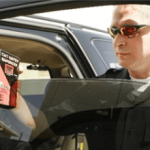OPINION
NEFF, J.
Claimant Cedrick Budd Spearman appeals as of right from the circuit court's order of forfeiture pursuant to MCL 33.7521(1)(f); MSA 14.15(7521)(1)(f). We reverse.
I
Approximately $ 275 was seized from claimant as a result of a police investigation of trespassing activity outside Palmer's Party Store in Grand Rapids. 1 As members of the Neighborhood Patrol Unit approached a group of people gathered in front of the store, a woman (later identified to be Cynthia McKinney) who had been leaning against the store near the fourteen-year-old claimant began to walk away from the group at a quick pace. McKinney, who had what appeared to be a bag in her left hand, made a motion toward her mouth, consistent with an attempt to conceal crack cocaine or other contraband by swallowing it. As an officer grabbed McKinney, she attempted to chew and swallow what appeared to be a bag containing approximately ten to fifteen lumps of crack cocaine. 2 A search of McKinney revealed no other evidence of concealed crack cocaine or money. No exchange of drugs for money was observed.
1 The area around Palmer's Party Store is well known to police as an area in which there is a heavy volume of drug trafficking and a significant amount of violence. The police department has a letter of intent from the owners of the store to prosecute trespassers.
2 McKinney was transported to a local hospital for observation. Medical records reveal that she had traces of cocaine in her system, and that part of the bag (along with what appeared to be pieces of crack cocaine) were subsequently found in her stool.
Meanwhile, other police officers focused their attention on claimant, who had been standing approximately three feet from McKinney. The officers observed no interaction between claimant and McKinney, and claimant made no gestures and had nothing in his hands. Claimant was advised that the officers were investigating a trespassing complaint at the store, and he consented to being searched. 3 Claimant had no weapons or drugs in his possession; however, in his pocket was $ 275 in currency, folded in half in one large bundle. When asked, claimant could not advise the officers how much money he had, and explained that his mother had given him the money to purchase some clothes.
3 On appeal, claimant challenges the search of McKinney and himself However, claimant's mere assertion that his constitutional rights were violated, without citations to the record and cogent argument supported by authority, is insufficient to present this issue for consideration by this Court. MCR 7.212(C)(7); People v Jones (On Rehearing), 201 Mich. App. 449, 456-457; 506 N.W.2d 542 (1993).
The Grand Rapids Police Department initiated forfeiture proceedings. At the hearing, testimony was presented that McKinney's possession of ten to fifteen lumps of crack cocaine was characteristic of a drug dealer. Also, the court was advised that it was common for McKinney not to have money on her, because drug dealers often work in teams so that one person handles the drugs and one handles the money. Further, testimony was presented that the bundle of cash recovered from claimant's pocket was significant because drug dealers commonly keep money stacked with larger denominations toward the back, with smaller denominations in front, all folded together.
Claimant testified at the hearing that his mother had given him three $ 100 bills to replace clothing that had been stolen in a break-in at his house. Claimant's mother corroborated this testimony, explaining that she had given claimant a portion of her income tax return. Claimant testified that he had repaid $ 25 that he had borrowed from his grandmother, and then changed the other two $ 100 bills at Palmer's. This assertion was contradicted by the owners of the store, who testified that not only did claimant not change the large bills at their store, but also that it was against their strict policy to do so.
In its opinion ordering forfeiture of the $ 275 discovered in claimant's possession, the circuit court determined that the police properly conducted an investigative stop when they observed a group of people violating a "no trespassing" order. The court further found that, pursuant to a valid search of claimant, the police were justified in seizing the money. Finally, the court found that the money was in "close proximity" to the drugs found on McKinney and that the police reasonably found a substantial connection between the money found on claimant and the illegal drug transaction. Accordingly, the court ordered the money forfeited. Claimant now appeals.
II
Pursuant to the controlled substances article of the Public Health Code, the following property is subject to forfeiture:
Any thing of value that is furnished or intended to be furnished in exchange for a controlled substance . . . that is traceable to an exchange for a controlled substance . . . or that is used or intended to be used to facilitate any violation of this article or section 17766a including, but not limited to, money, negotiable instruments, or securities. To the extent of the interest of an owner, a thing of value is not subject to forfeiture under this subdivision by reason of any act or omission that is established by the owner of the item to have been committed or omitted without the owner's knowledge or consent. Any money that is found in close proximity to any property that is subject to forfeiture under subdivision (a), (b), (c), (d), or (e) shall be presumed to be subject to forfeiture under this subdivision. This presumption may be rebutted by clear and convincing evidence. [MCL 333.7521(1)(f); MSA 14.15(7521)(1)(f).]
Forfeiture proceedings are in rem civil proceedings, and the prosecution has the burden of proving its case by a preponderance of the evidence. In re Forfeiture of $ 25,505, 220 Mich. App. 572, 574; 560 N.W.2d 341 (1996). We review the trial court's findings of fact for clear error, giving regard to the special opportunity of the trial court to judge the credibility of the witnesses who appeared before it. In re Forfeiture of $ 19,250, 209 Mich. App. 20, 29; 530 N.W.2d 759 (1995).
A
In the present case, the circuit court determined that forfeiture was warranted because the prosecution had established, by a preponderance of the evidence, that the $ 275 seized from claimant was substantially connected to the sale of crack cocaine. We disagree.
In order for an asset to be ordered forfeited because it was used or was intended to be used to facilitate a violation of the controlled substances act, the trial court must find a substantial connection between that asset and the underlying criminal activity. In re Forfeiture of $ 5,264, 432 Mich. 242, 262; 439 N.W.2d 246 (1989). Although a connection to a specific drug sale need not be shown, the assets must be traceable to drug trafficking. In re Forfeiture of $ 1,159,420, 194 Mich. App. 134, 146; 486 N.W.2d 326 (1992). "In contrast, property that has only an incidental or fortuitous connection to the unlawful activity is not subject to forfeiture." Id.
When he was stopped and searched by the police, claimant was standing approximately three feet from McKinney in an area well known for drug trafficking. McKinney possessed enough cocaine to support the presumption that she was selling it. See People v Ray, 191 Mich. App. 706, 708; 479 N.W.2d 1 (1991). Although testimony was presented that the growing trend is for drug dealers to work in teams in which one person holds the drugs and another holds the money, absolutely no interaction was observed between claimant and McKinney. No drug transaction or suspected drug transaction was observed involving either claimant or McKinney. Indeed, the two could have been complete strangers to one another. We find that "drug profile" evidence of this sort is of little value where, as here, there is no other persuasive evidence linking claimant to drug-related activity.
Claimant was in possession of $ 275, arguably a large amount of money for a fourteen-year-old boy, but hardly enough to suggest that the money was related to drug trafficking. The fact that the money was folded and in order by denomination is completely innocuous. Although we recognize that claimant's incredible statements regarding the source of the money may evidence possible criminal activity, they do not require an inference that the money was related to drug trafficking.
The above facts, viewed in the aggregate, create nothing more than a mere suspicion that the seized currency was linked to the suspected exchange of a controlled substance. More than a mere suspicion is required to establish, by a preponderance of the evidence, a substantial connection between the money seized from claimant and the exchange of a controlled substance.
B
The circuit court also determined that the money was found in "close proximity" to the crack cocaine discovered on McKinney and was thus presumed to be subject to forfeiture under MCL 333.7521(1)(f); MSA 14.15(7521)(1)(f). Again, we disagree.
Although the breadth of the term "close proximity" has not been expressly defined by the appellate courts of this state, other states have done so. We adopt the following analysis of the Arkansas Supreme Court:
"In close proximity" simply means "very near." For that reason it has been said that the meaning of the term in such a statute is to be determined on a case-by-case basis. [citation omitted.] We agree with that approach and do not mean by this opinion to suggest rigid rules for fixing "close proximity" by a particular number of feet, by reference to particular rooms, or by any rule of thumb. Limon v State, 285 Ark. 166, 168; 685 S.W.2d 515 (1985).
Like the Arkansas court, we are not inclined to define "close proximity" in precise terms. Rather, we hold that a common sense, case-by-case determination be made when determining whether money is in "close proximity" to other forfeitable property.
At first blush, the statutory presumption does not appear to require a nexus between the money and the forfeitable object; however, we believe that the two grounds for forfeiture contained in MCL 333.7521(1)(f); MSA 14.15(7521)(1)(f) ("substantial connection" and "close proximity") must be read harmoniously in order to give effect to the intent of the Legislature. We find support for this position in In re Forfeiture of $ 18,000, 189 Mich. App. 1, 4; 471 N.W.2d 628 (1991), where the Court held that although the money at issue had perhaps, at one time, been in "close proximity" to cocaine, it was not subject to forfeiture when it was not discovered in "close proximity" to the contraband. The Court noted that the statute's goal of deterring illegal trafficking in controlled substances "would not be furthered by reading the presumption of forfeiture to apply to the money in this case merely because it bears an odor of a controlled substance and could have been in "close proximity" to a controlled substance at some point in time." Id. Proof of "close proximity", without more, is insufficient to invoke the statutory presumption.
Turning to the facts before us, we conclude that the circuit court clearly erred in ordering the forfeiture of the $ 275 found in claimant's possession. That claimant was standing approximately three feet from another person who had enough cocaine to raise a presumption of an intent to deliver is insufficient to support a conclusion that the cocaine and claimant's money were in "close proximity" to each other for purposes of MCL 333-7521(1)(f); MSA 14.15(7521)(1)(f). Accordingly, the statutory presumption of forfeitability does not apply to the facts presented here. To rule otherwise would be tantamount to determining that the presumption exists whenever contraband and money are found within an arbitrary, artificially determined distance, without any other connection between them. Cf. People v United States Currency, 158 Mich. App. 126; 404 N.W.2d 634 (1986) (Court upheld the forfeiture of over $ 4,000 discovered in the possession of the claimant, who was found during a drug raid approximately 2 1/2 feet from a toilet in which cocaine was being flushed). Such a forced result would do nothing to further the intent of our Legislature in enacting the forfeiture statute, which was to control illegal drug trafficking, In re Forfeiture of $ 5,264, supra, 432 Mich. at 259, not to divest persons of all currency that happens to come within a certain distance of a forfeitable object.
III
Under the circumstances presented here, we hold that the circuit court clearly erred in finding that the money seized from claimant was both substantially related to the exchange of a controlled substance and in "close proximity" to property subject to forfeiture. Consequently, we reverse the court's order of forfeiture.
Reversed.
MacKenzie, J., concurred.
/s/ Janet T. Neff
/s/ Barbara B. MacKenzie
SMOLENSKI, P.J. (dissenting).
I respectfully dissent. I find that the circuit court did not clearly err in finding that the money seized from claimant was substantially related to, and therefore used to facilitate, the unlawful sale of cocaine. MCL 333.7521(1)(f); MSA 14.15(7521)(1)(f); In re Forfeiture of $ 5,264, 432 Mich. 242; 439 N.W.2d 246 (1989). I likewise find that the circuit court did not clearly err in finding that the money was in "close proximity" to the cocaine. MCL 333.7521(1)(f); MSA 14.15(7521)(1)(f). Accordingly, I would affirm the court's order of forfeiture.
/s/ Michael R. Smolenski





